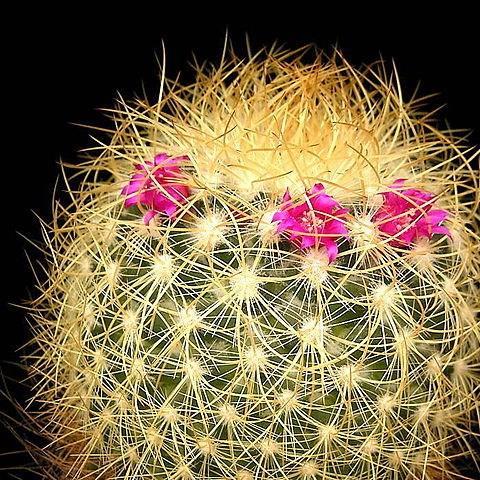
Mammillaria rhodantha
Rainbow Pincushion
Mammillaria Rhodantha forms cells that are globular at first later becoming columnar to 30cm in height and 10cm in diameter. Spines vary in color from yellow to orange or red. Magenta flowers appear in late spring summer and again in autumn. M. rhodantha is an easy-to-flower and easy to grow cactus.
Contributed by @magorc
-
Full sun
-
Very little water
-
A little frost hardy: 32F (0°C)
-
Light and free draining
Common name
Rainbow Pincushion
Latin name
Mammillaria rhodantha
type
Succulent
family
Cactaceae
ph
5.0 - 7.0 Acid - Neutral
Plant & bloom calendar
-
Best time to plant
full grown dimensions
 0.10 M
0.30 M
0.10 M
0.30 M
Mammillaria rhodantha
Mammillaria Rhodantha forms cells that are globular at first later becoming columnar to 30cm in height and 10cm in diameter. Spines vary in color from yellow to orange or red. Magenta flowers appear in late spring summer and again in autumn. M. rhodantha is an easy-to-flower and easy to grow cactus.
Planting outdoors
From Early Spring TO Late Spring
Only a select few cactus will survive outside in temperate climates, because of winter rains and low temperatures. In selecting plants for use outside, one must look at the habitat from which the plant originates. It must have sun most of the day. Morning and afternoon sun is better than two o clock sun. The area should have very good drainage, this is more important in the winter than the summer. Most cactus are not killed by the cold, but when the water inside the plant freezes it expands and splits the outer layer of skin, this allows bacteria to enter the plant and kill it.
Propagation
From Early Spring TO Late Summer
The habit of the cacti and succulents will give you an indication as to which method of propagation will suit it; Branching habits can have their side shoots and stem removed to produce stem cuttings. Columnar types are propagated by stem cutting. Clump-forming species readily produce offsets which can be lifted and divided. Some fleshy leaves make great leaf cuttings, which are so simple and great fun.
Planting in pots
From Early Spring TO Late Winter
Potting mixes can be made by mixing one part potting mix, one part washed sand & one part course fill (rocks, pumas, broken pots, etc.) Don`t worry too much drainage is better than not enough. When planting the cactus never dig a deep hole down in the potting mix. You want the plant to set on top of the potting mix, this allows the roots to go down to get moisture with out the plant setting in wet soil. A potted cactus will live and flower in the house if given enough light, place the plant near a bright lighted window, where it will receive light most of the day. On the patio is different place the cactus in a partly shaded area until it become accustom to the sun.
Propogation by cuttings and offsets
From Early Spring TO Late Winter
Most cuttings require time to dry and produce a callus on the wound, this can take from a week to a day depending on size and type. Use John Innes No 1 with up to 30 percent by volume of added grit and keep the compost on the dry side to prevent the cutting rotting off. Always check what your individual specimen will require.
Propagation by seed
From Early Spring TO Late Spring
Many species can also be grown from seed; Use John Innes No 1 with added grit or sand for added drainage. Sow the seed in spring. Large seed will need a covering of one to two times the depth of the size of the seed. Small fine seed should not be covered, but mix the seed with a little sand to help with an even distribution. Water with a misting bottle or a watering can with a fine rose and cover the pot with a sheet of glass or plastic bag. Keeping them at 21°C in partial shade. Allow air into the pot daily by removing glass or plastic bag and wiping off condensation. Keep moist but not overly wet. Pot on seedlings when they are big enough to handle. It can take up to 12 months for them to reach this stage.

















